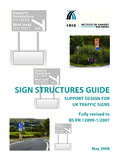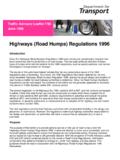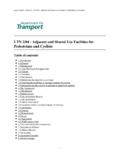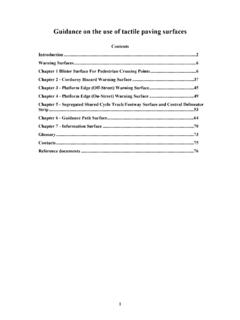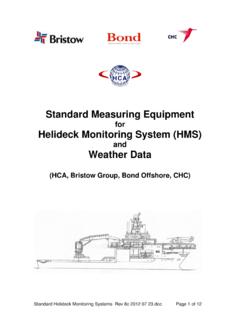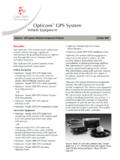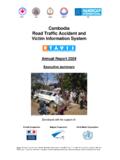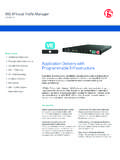Transcription of The SCOOT Urban Traffic Control System - UK Roads
1 Traffic Advisory Leaflet 4/95. April 1995. The & quot ; SCOOT & quot ; Urban Traffic Control System Introduction each junction in turn is relatively simple. Co- The SCOOT Urban Traffic Control System was ordinating signals over a network of conflicting developed by the Transport Research routes is much more difficult. Laboratory (TRL) in collaboration with the UK. Traffic systems industry 1 . SCOOT is an Computer techniques have been developed to adaptive System which responds automatically calculate optimum signal settings for a signal to Traffic fluctuations. It does away with the network.
2 TRANSYT, developed by TRL, is need for signal plans which are expensive to probably the best known example. TRANSYT. prepare and keep up to date 2 . SCOOT has can be used to compile a series of fixed time proved to be an effective and efficient tool for signal plans for different times of day or for managing Traffic on signalised road networks special recurring Traffic conditions. Preparing and is now used in over 130 towns and cities such signal plans requires Traffic data to be in the UK and overseas. collected and analysed. This is time consuming and expensive, and the resulting This leaflet is intended to draw the attention of plans should be updated regularly as Traffic highway authorities (in Scotland, Roads patterns change.)
3 To overcome these authorities) to the advantages of SCOOT . problems, the concept of a demand Some authorities may not be aware of the responsive UTC System was developed. benefits of installing SCOOT . Others which already have SCOOT systems may not be The first generation of demand responsive getting the best out of them or appreciate the systems monitored Traffic flows continuously benefits of extending or updating them. and triggered the most appropriate plan from SCOOT has been improved in recent years, the library. Second generation systems used and research currently in hand by TRL and the current Traffic counts to update historical data SCOOT suppliers will deliver further and produce new plans.
4 However, this often improvements in the near future. led to frequent plan changing which caused disruption and often sub-optimal plan The Development of SCOOT changes. In Urban areas where Traffic signals are close In the late 1970s, TRL developed a together, the co-ordination of adjacent signals methodology to overcome these problems. An is important and gives great benefits to road on line computer continuously monitored Traffic users. Linking Traffic signals along a single flows over the whole network and made a route so that vehicles get a green signal at series of frequent small adjustments to signal timings to reduce delays and improve Traffic On average, it is estimated that SCOOT would flow.
5 This was the basis of SCOOT . reduce delays by approximately 12% against up-to-date and 20% over a typical fixed-time System . In 1993 a SCOOT demonstration 6 project in Toronto, Canada showed an average reduction in vehicle delays of 14% over the existing fixed time plans. during weekday evenings and Saturdays, vehicle delays were reduced by 21% and 34%. In unusual conditions following a baseball game, delays were reduced by 61%, demonstrating SCOOT 's ability to react to unusual events. It was also estimated that updating the Toronto's fixed time plans would require 30 person years of effort.
6 How SCOOT Works The kernel software at the heart of a SCOOT . System is standard to all installations 7 . The additional software (the & quot ;knitting& quot ; software). which links the SCOOT kernel to on street equipment and which provides the user interface is specific to the supplier. SCOOT sends out instructions to the & quot ;on street& quot ; equipment using dedicated telephone lines. These instructions are interpreted and acted upon by Traffic signal equipment at the Benefits of SCOOT roadside. The equipment replies to the central computer confirming the acceptance of instruction, or detailing a fault condition.
7 The benefits of SCOOT compared to alternative methods of Control have been well documented 3 . Journey time surveys in SCOOT obtains information on Traffic flows Worcester 4 and Southampton 5 found that from detectors. As an adaptive System , SCOOT Control reduced delays substantially SCOOT depends on good Traffic data so that it compared with vehicle actuated ( non co- can respond to changes in flow. Detectors are ordinated) signal operation. Typical delay normally required on every link. Their location reductions were 23% in Worcester and 30% in is important and they are usually positioned at Southampton.
8 The upstream end of the approach link. Inductive loops are normally used, but other methods are being developed. Comparisons of the benefits of SCOOT , with good fixed time plans, showed reductions in delays to vehicles of 12% in Glasgow and When vehicles pass the detector, SCOOT . 27% at Folsehill Road in Coventry. Surveys converts the information into & quot ;link profile units& quot ;. were taken throughout the day in various (lpu), a hybrid of link flow and occupancy. This locations, including a very dense Urban is the unit used by SCOOT in its calculations. network in the centre of Glasgow and a radial & quot ;Cyclic flow profiles& quot ; of lpu's over time are network in Coventry with longer link lengths.
9 In constructed for each link. practice, fixed time plans go out of date as Traffic patterns change, on average by about A SCOOT network is divided into & quot ;regions& quot ;, 3% a year, so the benefits of SCOOT over an each containing a number of & quot ;nodes& quot ;. older fixed time plan would be even greater. (signalled junctions and pedestrian crossings which are all run at the same cycle time to allow co-ordination). Nodes may be & quot ;double flow profiles predicted for each of the links with cycled& quot ; ( operate at half of the regional upstream or downstream nodes. It then cycle time) at pedestrian crossings of assesses whether the existing action time undersaturated junctions.
10 Region boundaries should be advanced, retarded or remain the are located where links are long enough for same in 4 second increments. lack of co-ordination not to matter. The Cycle Time Optimiser operates on a region basis once every five minutes, or every two and a half minutes when cycle times are rising rapidly. It identifies the & quot ;critical node& quot ;. within the region and will attempt to adjust the cycle time to maintain this node with a 90%. link saturation on each stage. If it calculates that a change in cycle time is required, it can increase or decrease the cycle time in 4, 8 or 16 second increments.
